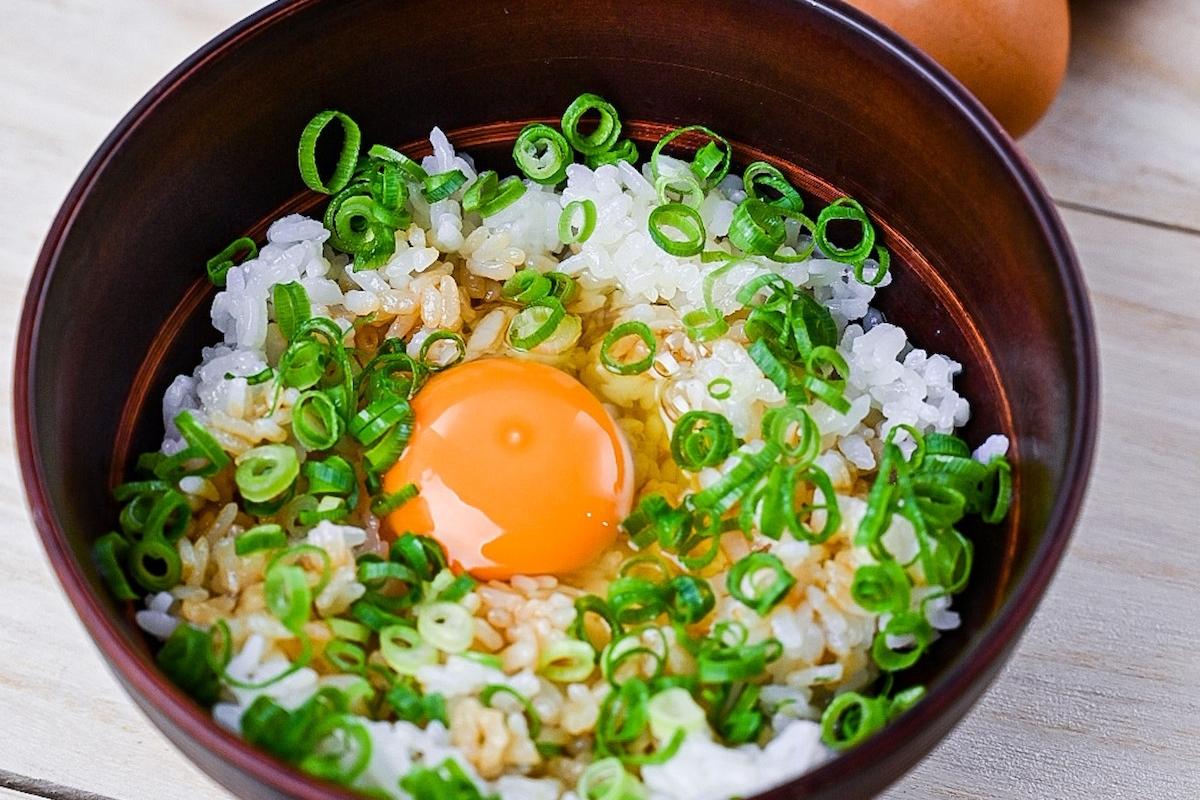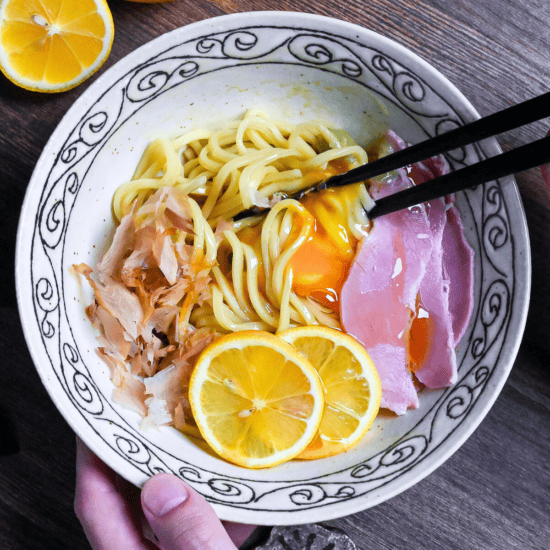What is Tamago Kake Men (TKM)?
Tamago Kake Men (たまごかけ麺), or TKM for short, is a new innovation that emerged in recent years by applying the beloved concept of TKG (Tamago Kake Gohan, or rice with raw egg) to noodle dishes. As the name suggests, this dish simply replaces the rice in traditional TKG with ramen noodles, creating a simple combination of freshly boiled noodles, raw egg, and savory sauce.
If you ever wanted to enjoy TKG, but didn’t have the time to cook a fresh batch of rice, then this recipe just might be what you’re looking for!

The TKM originated at “Golden Tiger,” a ramen restaurant in Kumagaya City, Saitama Prefecture. The trend gained significant momentum when Mita Seimenjo commercialized their product in 2023 to commemorate their 15th anniversary. This creation became an instant sensation, using an astonishing 10,000 eggs in just one week after its release!
That said, much like TKG, there’s no single definitive way to prepare. There are countless delicious variations to explore. In this recipe article, I’m excited to share my personal TKM recipe!

Visual Walkthrough & Tips
Here are my step-by-step instructions for how to make TKM at home. For ingredient quantities and simplified instructions, scroll down for the Printable Recipe Card below.
This section aims to provide a comprehensive overview of the cooking steps and techniques with visuals. It also includes more in-depth tips and tricks and explains why I do what I do.

Fill a large pot with water and bring it to a rolling boil over high heat. For the best TKM experience, use thick ramen noodles similar to those used for tsukemen. Their substantial texture makes them perfect for the egg and sauce.

Add the noodles to the boiling water and cook them al dente, a little less than the time stated on the packaging.
Since different brands and types of ramen noodles have different cooking times, my general rule is reduce it by 10 seconds for every 1 minute suggested on the packaging. So for 1 minute, it would be 50 seconds, for 3 minutes it would be 2 minutes 30, and so on.
If you cook the noodles a bit firmer, they’ll keep their texture when they’re cooled and mixed with the sauce and egg. If you overcook ramen noodles, they’ll get mushy and won’t have that satisfying chewy texture that makes TKM. It’s like the same idea you use when you cook pasta for cold pasta salads.
While the noodles cook, gently stir occasionally to prevent sticking.
If you can’t get fresh ramen noodles, you can use soba noodles, udon noodles, or spaghetti instead, but please be aware that it won’t be an authentic TKM.

While your noodles are boiling, you can make the umami-rich sauce that forms the foundation of this dish. In a small saucepan, mix together soy sauce, mirin, sake, oyster sauce, sugar, and dashi granules.
Heat this mixture over medium-low heat for about a minute. This will burn off the alcohol in the mirin and sake, and it’ll blend the flavors.
Remove it from the heat right away to prevent reduction and flavor concentration.
This sauce is great for emulsification with the egg. The proteins in the dashi, along with the natural glutamates in the soy sauce and oyster sauce, create a strong umami base. And the slight sweetness from the mirin and sugar balances out the saltiness.

When the noodles are just right, drain them in a colander and rinse them under running water. Keep rinsing and tossing the noodles with your fingers until they’re about body temperature (around 40°C).
This step is important for two reasons:
- It stops the cooking process.
- It brings the noodles to the ideal temperature for the raw egg.
If the noodles are too hot, the egg proteins will coagulate too quickly (this happens between 54-70°C), and you’ll lose the creamy texture that makes TKM special. And if the noodles are too cold, the egg won’t emulsify with the sauce the right way.
Once they reach body temperature, give the colander a good shake. This will get rid of any extra water, which can mess with the sauce and the flavor.


Divide the sauce evenly among the bowls. Then, place your drained noodles on top of the sauce, creating a little nest in the center. Carefully crack the egg into the center hollow of your noodles.
If you want the best TKM experience, go for eggs with rich, orange-red yolks. These eggs usually have more carotenoids and offer a stronger flavor. And, of course, make sure you use pasteurized eggs for this dish!
Now it’s time to personalize your TKM with toppings! My version includes toasted sesame oil, dried bonito flakes (katsuobushi), sliced ham, wasabi paste, and a slice of fresh lemon.

While these toppings are delicious, TKM is incredibly versatile. Some alternative ideas include:
- Pork chashu
- Mentaiko (spicy cod roe)
- Finely chopped green onions
- Crushed nori seaweed
- Crispy bacon
- Tempura flakes
- Menma
- Chili oil
It’s also great with a drizzle of sesame oil.

Now, it’s time for the important step that ties everything together. Use chopsticks to stir the mixture about 30 times in a circular motion. You’ll see the egg change from a separate white and yolk to a creamy, cloud-like sauce that coats each strand of noodle.

You’ll see the texture change right before your eyes – after about 20-25 stirs, the mixture becomes noticeably fluffier and takes on a pale golden hue.
Because TKM uses raw egg, it’s best consumed immediately after preparation and not stored for later.
Some TKM enthusiasts even add a small amount of rice at the end to soak up the remaining sauce – a nod to the dish’s TKG roots. If you’re still hungry and have some rice leftover in the fridge or freezer, I recommend giving it a try!

Essential Tips & Tricks
- Noodle Texture Is Key: Cook your noodles al dente for the perfect chewy texture.
- Temperature Management: Cool noodles to body temperature – hot enough to emulsify the egg but not so hot that it cooks the egg proteins.
- Water Removal: Thoroughly drain excess water from the noodles to prevent diluting your sauce.
- Egg Quality Matters: Use room-temperature eggs with rich, orange-red yolks for better emulsification and flavor.
- The Magic Number: Stir approximately 30 times in a circular motion to achieve the perfect consistency without breaking the noodles.
With these simple tips in mind, you’re set for success every time you make TKM.

I hope you enjoy this TKM recipe! If you try it out, I’d really appreciate it if you could spare a moment to let me know what you thought by giving a review and star rating in the comments below. It’s also helpful to share any adjustments you made to the recipe with our other readers. Thank you!
More Recipes Like This

Tamago Kake Men (TKM Japanese Egg on Noodles)
Ingredients
- 2 ptn ramen noodles fresh, thick tsukemen-style, or soba/udon noodles
- 2 pasteurized eggs room temperature, premium with rich orange-red yolks if possible
Sauce
- 1 ½ tbsp Japanese soy sauce (koikuchi shoyu)
- 1 ½ tbsp mirin
- 1 ½ tbsp sake
- ½ tsp sugar
- ½ tsp dashi granules preferably bonito and kombu blend
- ½ tsp oyster sauce
Topping suggestions
- toasted sesame oil 1 tbsp per serving
- ham or protein of choice. Chashu or chicken breast also works well.
- lemon sliced
- bonito flakes (katsuobushi) 2 tbsp per serving
- wasabi paste small amount, to taste
My recommended brands of ingredients and seasonings can be found in my Japanese pantry guide.
Can’t find certain Japanese ingredients? See my substitution guide here.
Instructions
- Bring a pot of water to a rolling boil and add 2 ptn ramen noodles. Take 10 seconds away from every minute of cooking according to the package instructions to achieve al dente. (1 minute minus 10 seconds becomes 50 seconds, etc.) Stir occasionally.

- While the noodles are boiling, take a small pan and add 1 ½ tbsp Japanese soy sauce (koikuchi shoyu), 1 ½ tbsp mirin, 1 ½ tbsp sake, ½ tsp oyster sauce, ½ tsp sugar, and ½ tsp dashi granules. Mix and heat over medium-low, let it bubble for about 1 minute then remove from the heat.

- Once the noodles are cooked, drain them and rinse them under running water until they reach a little over body temperature (approx 40 °C (104 °F)).

- Divide the sauce between serving bowls.

- Place the noodles on top and make a well in the center. Crack a pasteurized egg into the space.

- Add your choice of toppings. I add ham, toasted sesame oil, lemon, bonito flakes (katsuobushi), and wasabi paste.

- Mix thoroughly, about 20-25 times until the egg has emulsified with the sauce and coated the noodles. Enjoy!

Notes
- Cool noodles to approximately body temperature – this is the ideal temperature zone where eggs won’t cook but will properly emulsify.
- Thoroughly drain excess water from noodles to prevent diluting the sauce.
- For a TKG-inspired finish, add a small portion of rice at the end to soak up remaining sauce.



Good excellent yummy
Thank you so much, Remigius!